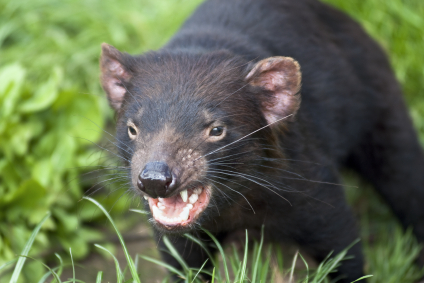 If you are of a certain age, the name “Tasmanian Devil” most likely conjures up an image of a ferocious brown hairy cartoon character that traveled in the center of a tornado of chaos. Sometimes, as in this case, the truth is much less strange than the fiction. The real Tasmanian Devils (Sarcphilus harrisii) are relatively small, somewhat cuddly looking, marsupials found only on the island of… you guessed it, Tasmania. Despite their diminutive size, they are the largest living carnivorous marsupial. Unfortunately, these terrier-sized animals are also in danger of becoming extinct, largely as a result of a deadly, infectious transmissible cancer called Devil Facial Tumor Disease (DFTD).
If you are of a certain age, the name “Tasmanian Devil” most likely conjures up an image of a ferocious brown hairy cartoon character that traveled in the center of a tornado of chaos. Sometimes, as in this case, the truth is much less strange than the fiction. The real Tasmanian Devils (Sarcphilus harrisii) are relatively small, somewhat cuddly looking, marsupials found only on the island of… you guessed it, Tasmania. Despite their diminutive size, they are the largest living carnivorous marsupial. Unfortunately, these terrier-sized animals are also in danger of becoming extinct, largely as a result of a deadly, infectious transmissible cancer called Devil Facial Tumor Disease (DFTD).
First reported in 1996, DFTD is a rapidly metastasizing cancer that is transferred as an allograft by physical contact between two animals. The disease has a mortality rate of 100%, and within the next five years it will most likely have spread across the entire island of Tasmania (1). With their apparent inability to effectively mount an immune response to the tumors, it seems that the survival of the breed will depend upon the gene pool of captive populations, which won’t be exposed to DFTD. This means maintaining the highest genetic diversity possible when selecting the individuals that will make up this population. Towards this end, researchers from Pennsylvania State University set about to sequence the genome of the Tasmanian Devil (1).
They started with two individuals from the extreme southeast and northwest regions of Tasmania, as far apart, geographically, as you can get on an island, and performed whole-genome sequencing on both individuals (named Spirit and Cedric by the researchers) as well as a tumor found on one of them. Using these results, they determined the genetic diversity between the three samples. Single nucleotide polymorphisms (SNPs) are genome positions where the nucleotide difference can be called with confidence. Within the three samples sequenced, the researchers identified 1,057,507 SNPs, and between Cedric and Spirit they found 914,827 substitutions. By way of comparison, there were 4,800,466 substitutions between a southern African Bushman and a Japanese individual and 3,256,979 between a Chinese individual and a Japanese individual. So although the diversity in the Tasmanian Devil population is significantly less than in humans, there is enough to be considered when planning captive breeding programs.
Further sequencing of mitochondrial genomes from wild and captive individuals, as well as some historic samples, allowed the researchers to identify four region-specific haplogroups. In addition, a fifth minor haplogroup was also found. When they looked at the historical information available, they found that the mitochondrial diversity was stable over the last 100 years.
The Challenge of the Disease
DFTD is different from other cancers in that it is an infectious cell line. The tumors are in essence grafted onto a new host whose genetic makeup is different from the original genetic makeup of the tumor. Genetic analysis of the disease must there for take into account the diploid genome of the present host, the diploid genome of the original host as well as mutations of the tumor over many host generations. Although they could identify differences in the genome makeup, it was impossible for the researchers to determine what differences came from the original host and what changes were the results of somatic mutations.
Sequencing of the tumor showed 118,575 substitutions that were unique to the tumor. This large variation confirms that the tumor did not originate in a cell from the host (Spirit). Instead, the tumor contains DNA from different individual. By segregating Spirit normal alleles, Spirit tumor alleles and alleles from the original host, the researchers estimated that 30% if the nuclear DNA and 15% of the mitochondrial DNA in the tumor samples came from Spirit. Thus, they could determine the amount of “contamination” from Spirit DNA to expect in the tumor samples.
Moving Ahead
The stability of the mitochondrial diversity over the last century offers hope that Tasmanian Devils have the genetic depth to survive if the current diversity can be maintained while DFTD runs its course through the wild population. To supplement current captive breeding programs, authors suggest selecting individuals equally from the across Tasmania, including the diseased region. This will best ensure that the genetic diversity currently found in the wild population will be maintained. They speculate that including healthy individuals from the disease-affected area might capture genetic content that could offer some protection from DFTD.
The author’s goal was to offer some genomic resources to assist in the conservation of Sarcphilus harrisii. Towards this end, they are making available the genomic contigs, alignment of the reads of those contigs, the complete set of SNP predictions with allele calls, and the alignments of annotated Monodelphis protein coding exons to Sarcophilus contigs. All these will help plan and maintain the diversity of the Sarcphilus harrisii populations.
References
- Miller, W. et al. (2001) Genetic diversity and population structure of the endangered marsupial Sarcophilus harrisii (Tasmanian devil). Proc. Natl. Acad. Sci. Jun 27. [Epub ahead of print].
Kelly Grooms
Latest posts by Kelly Grooms (see all)
- Don’t Flush Your Kitty Litter! Toxoplasmosis Is a Growing Threat to Sea Otters and Other Marine Mammals - November 12, 2024
- Tardigrade Proteins Might Solve the Cold Chain Problem for Biologics - October 17, 2024
- Mpox—The Latest Zoonotic Virus Making Headlines - September 12, 2024
